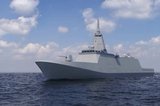Sonardyne's Sentinel sonar deployed for IMCMEX
Sonardyne's Sentinel Intruder Detection Sonar (IDS) has been successfully deployed during the International Mine Counter-Measures Exercise (IMCMEX) in Bahrain, the company said on 10 March.
IMCMEX was a three-week exercise that saw 6,500 personnel and 38 warships from 44 navies take part.
During the exercise, the US Navy operated the Sentinel IDS in a variety of scenarios to demonstrate its capabilities in protecting high-value marine assets. Divers from other participating navies were tasked with evading detection of the IDS during simulated assaults, and the system proved successful in alerting operators to each approaching threat.
The Sentinel IDS was developed to detect small underwater targets such as divers, providing local underwater situational awareness. It is currently deployed in military ports, harbours, vessels and shore side critical national infrastructure, commercial ports and vessels. The system can detect, track and classify targets such as underwater vehicles, divers and surface swimmers approaching a protected asset up to 1km away from all directions.
The 2015 IMCMEX included maritime security operations such as escorting and defending commercial shipping, and maritime infrastructure protection for oil rigs and harbours.
Nick Swift, business manager for maritime security, Sonardyne, said: 'With a quarter of the world's navies in attendance, this was the perfect environment to demonstrate Sentinel’s capabilities in protecting high value offshore facilities, ports and critical waterside infrastructure.'
More from Naval Warfare
-
![US Navy advances with the Harpoon Service Life Extension Programme]()
US Navy advances with the Harpoon Service Life Extension Programme
The US Navy plans to improve Harpoon’s anti-ship and land attack capabilities by equipping the missiles with sensors and technologies required for succeeding in future battlespace.
-
![Mitsubishi eyes future with Australia’s Mogami selection]()
Mitsubishi eyes future with Australia’s Mogami selection
With Australia’s selection of the Mogami-class for Project Sea 3000, Mitsubishi is investigating local production in the next decade as potential export opportunities emerge.
-
![Hanwha wins Australian government approval to increase its stake in Austal]()
Hanwha wins Australian government approval to increase its stake in Austal
The contract would mean the two shipbuilders can collaborate strategically and enhance shipbuilding capabilities in Western Australia.






















